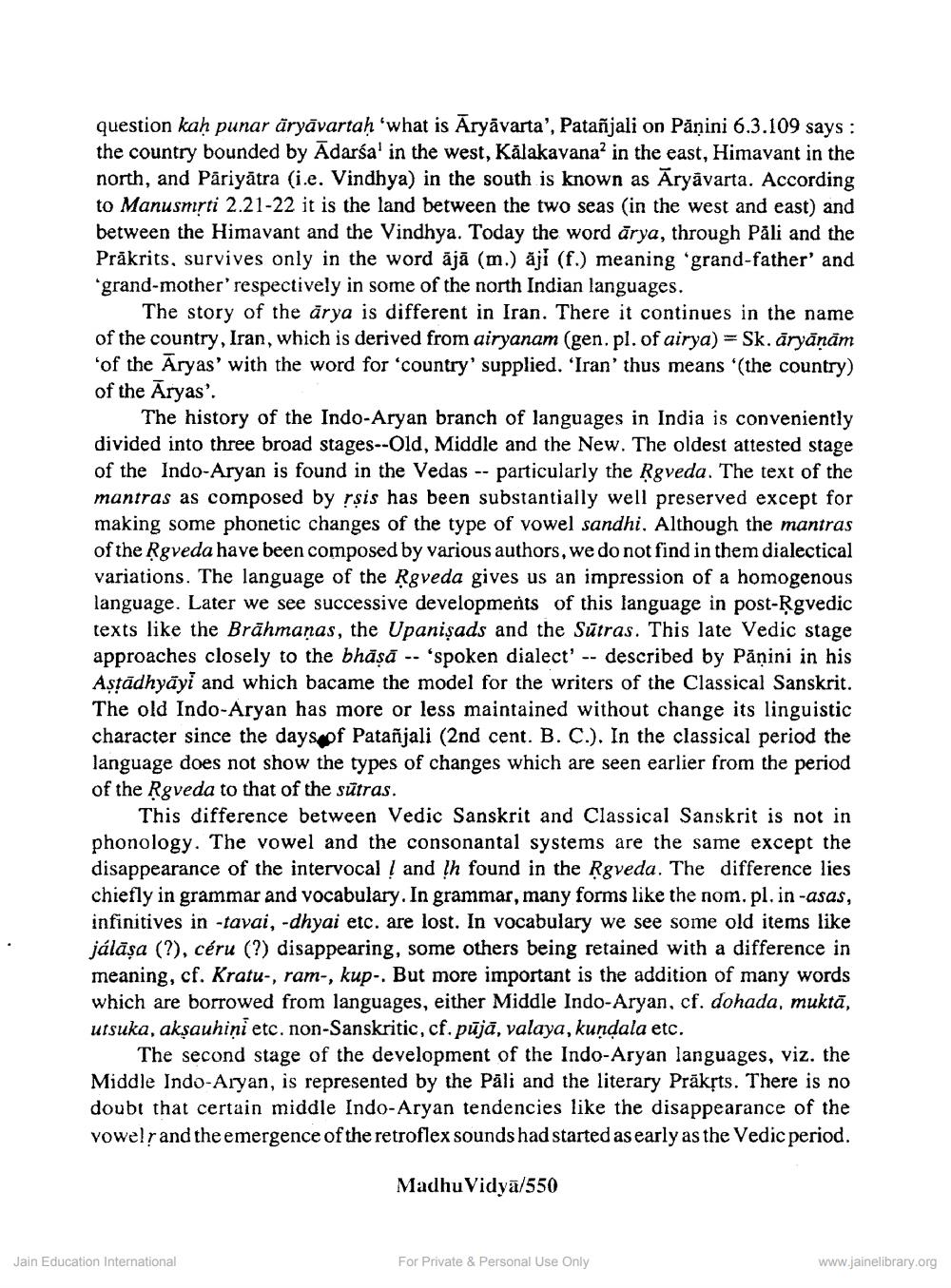________________
question kah punar āryāvartah 'what is Āryāvarta', Patañjali on Panini 6.3.109 says: the country bounded by Adarśa' in the west, Kalakavana? in the east, Himavant in the north, and Päriyātra (i.e. Vindhya) in the south is known as Āryävarta. According to Manusmrti 2.21-22 it is the land between the two seas (in the west and east) and between the Himavant and the Vindhya. Today the word ārya, through Pali and the Prakrits, survives only in the word ājā (m.) äji (f.) meaning 'grand-father' and 'grand-mother' respectively in some of the north Indian languages.
The story of the arya is different in Iran. There it continues in the name of the country, Iran, which is derived from airyanam (gen. pl. of airya) = Sk. āryānām 'of the Aryas' with the word for 'country'supplied. 'Iran' thus means '(the country) of the Aryas'.
The history of the Indo-Aryan branch of languages in India is conveniently divided into three broad stages--Old, Middle and the New. The oldest attested stage of the Indo-Aryan is found in the Vedas -- particularly the Rgveda. The text of the mantras as composed by rsis has been substantially well preserved except for making some phonetic changes of the type of vowel sandhi. Although the mantras of the Rgveda have been composed by various authors, we do not find in them dialectical variations. The language of the Rgveda gives us an impression of a homogenous language. Later we see successive developments of this language in post-Rgvedic texts like the Brāhmanas, the Upanişads and the Sūtras. This late Vedic stage approaches closely to the bhāsā -- 'spoken dialect' -- described by Panini in his Astādhyāyi and which bacame the model for the writers of the Classical Sanskrit. The old Indo-Aryan has more or less maintained without change its linguistic character since the days of Patañjali (2nd cent. B. C.). In the classical period the language does not show the types of changes which are seen earlier from the period of the Rgveda to that of the sūtras.
This difference between Vedic Sanskrit and Classical Sanskrit is not in phonology. The vowel and the consonantal systems are the same except the disappearance of the intervocal | and lh found in the Rgveda. The difference lies chiefly in grammar and vocabulary. In grammar, many forms like the nom.pl. in-asas, infinitives in -tavai, -dhyai etc. are lost. In vocabulary we see some old items like jálāșa (?), céru (?) disappearing, some others being retained with a difference in meaning, cf. Kratu-, ram-, kup. But more important is the addition of many words which are borrowed from languages, either Middle Indo-Aryan, cf. dohada, muktā, utsuka, akşauhiņi etc. non-Sanskritic, cf. pūjā, valaya, kundala etc.
The second stage of the development of the Indo-Aryan languages, viz. the Middle Indo-Aryan, is represented by the Páli and the literary Prāksts. There is no doubt that certain middle Indo-Aryan tendencies like the disappearance of the vowelr and the emergence of the retroflex sounds had started as early as the Vedic period.
Madhu Vidyā/550
Jain Education International
For Private & Personal Use Only
www.jainelibrary.org




